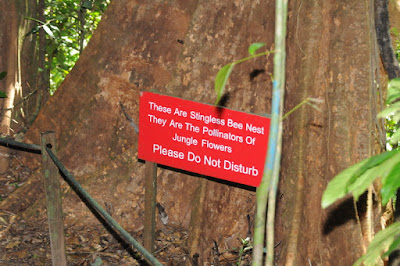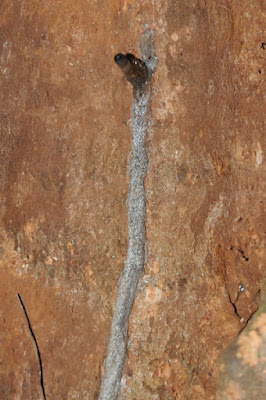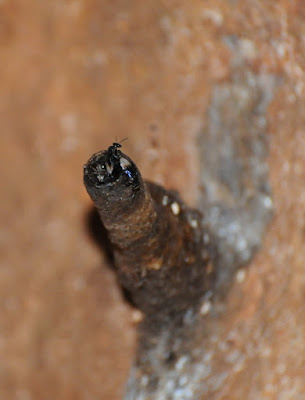With one thing and another, my spring 2011 trip to Sarawak did not give me many chances to get out birding. So when my friend (and first-rate birding guide) Yeo Siew Teck offered to take me to Kubah National Park near Kuching on May 8, 2011 (yes, I'm slightly out of chronological sequence), I was very glad indeed for the chance - especially since Yeo is particularly good at ferreting out one of the most difficult birds to coax into view in Borneo, the endemic Blue-banded Pitta (Pitta arcuata).
I had heard Blue-banded Pittas before, both at Kubah and at Borneo Highlands near the upper end of their altitudinal range, but despite literally hours of waiting they had never been more than a voice, a long, low clear whistle coming out of the undergrowth (quite similar to that of other forest undergrowth birds in many parts of the world; whistled calls carry better, and degrade less, in the echo-prone atmosphere beneath the understorey of a tropical forest than up in the canopy or out in the open).
The trick to actually seeing one, according to Yeo, is an even longer, quiet, patient wait, playing a recording or whistling an imitation of its song, while the bird slowly crosses its territory in what you hope is your direction. It can literally take hours.
The trick to actually seeing one, according to Yeo, is an even longer, quiet, patient wait, playing a recording or whistling an imitation of its song, while the bird slowly crosses its territory in what you hope is your direction. It can literally take hours.
I am well aware, by the way, that many birders would object to such lengthy use of playback, and since my visit I have seen evidence that playback may have deleterious effects on the breeding success of at least some species of birds. I have no idea what this means for pittas, especially considering that searches such as ours are hardly a daily occurrence.
So, our day in the forest involved not hiking, but sitting or standing quietly in one spot. As it turned out, it was two or three different spots. One disadvantage of visiting Kubah on a Sunday is that you are not likely to be the only one there. More than once, a long wait was disrupted, just as the bird appeared to be working up to showing itself, by a noisy (if friendly) group of hikers (playing a radio in one case) passing by at just the wrong moment.
As a result we finally abandoned attempts to see a pitta along the main road through the park, and descended the Waterfall Trail into the territory of, perhaps, the same bird David Bakewell and I had failed to lure into view two years ago. There were hikers, there too, but at least the bird didn't have to approach the forest edge to be seen.
Waiting for hours in a tropical forest has its compensations. For those who can't imagine why anyone would do such a thing for pleasure, I can only say that if you do have to wait around in one spot for a long time a tropical forest is a wonderful place to do it. Waiting gives you a chance to notice details, and no land environment has more details than a rain forest.
Wait long enough, and all sorts of fascinating little creatures may cross your path. Here, for example, is a harvestman, doggedly clambering its way over the leaf litter. Harvestmen, by the way, are not spiders; they belong to their own, related order, Opiliones. For one thing, the body is in a single piece, rather like Humpty Dumpty, instead of being divided into a cephalothorax and abdomen as in true spiders. This one appears to be a common species in Sarawak, but I have been unable to find out its name.
Even flies can be fascinating (as long as they don't bite). This metallic little greenbottle (well, that's what I'd call it in Canada) seemed, fortunately, quite uninterested in my blood supply.
Even more brilliantly green was this Vestalis damselfly (probably Vestalis amoena) that repeatedly perched near us as we squatted on the forest floor.
At times the odd butterfly stopped in...
This one would appear to be a Spotted Black Crow (Euploea crameri).
Wait long enough, and all sorts of fascinating little creatures may cross your path. Here, for example, is a harvestman, doggedly clambering its way over the leaf litter. Harvestmen, by the way, are not spiders; they belong to their own, related order, Opiliones. For one thing, the body is in a single piece, rather like Humpty Dumpty, instead of being divided into a cephalothorax and abdomen as in true spiders. This one appears to be a common species in Sarawak, but I have been unable to find out its name.
Even flies can be fascinating (as long as they don't bite). This metallic little greenbottle (well, that's what I'd call it in Canada) seemed, fortunately, quite uninterested in my blood supply.
Even more brilliantly green was this Vestalis damselfly (probably Vestalis amoena) that repeatedly perched near us as we squatted on the forest floor.
At times the odd butterfly stopped in...
This one would appear to be a Spotted Black Crow (Euploea crameri).
On our way between unseen pittas, we passed one tree with its insects clearly marked.
Running up its trunk were long grey tubes, the work of a colony of stingless bees (Apidae, Meliponini; possibly members of the genus Trigona). Stingless bees are important pollinators of forest trees in Sarawak, and in turn require the trees to house their colonies. The moral of the story is that the conservation of even tiny creatures is a must if places like Kubah are to retain their interest and beauty.
Even when the insects aren't around, there are always details of the plant life to admire (if not, unfortunately, identify).


Flight to a new perch was not a quiet affair. Every time the pitta flew it was accompanied by a remarkable series of deep, loud clicks (make a "clock" sound with your tongue - you'll get the idea). I had never heard these sounds on recordings, so I was quite startled the first time the bird made them. Were they vocal or mechanical, produced somehow by the wing or tail feathers? I tried to find out - but could not come up with a single reference on the matter. How little we know about Sarawak's birds!
This, by the way, is the hundredth published post for A Wandering Naturalist. It's a good place to say "thank you" to my readers, followers and commentators, to the various experts that have helped me with identification, and to my friends and family in Sarawak and elsewhere (and, of course, to Eileen). To all of you - and to anyone else who happens by - stick around, thee's more to come!



















The walking stick is pretty cool.
ReplyDelete